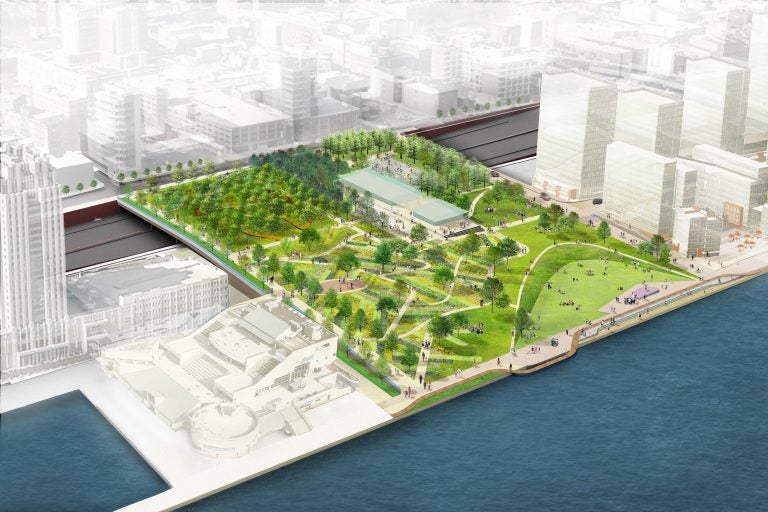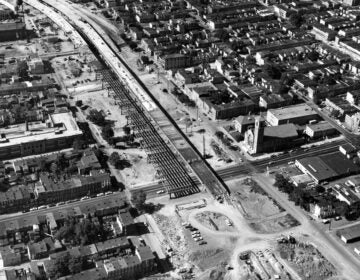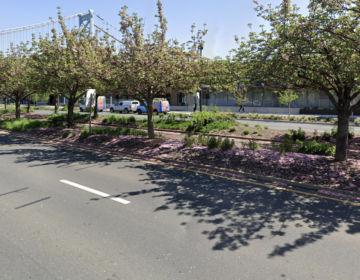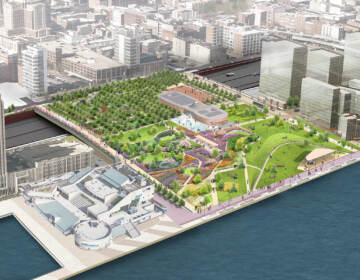Groundbreaking on Penn’s Landing park over I-95 highway trench pushed back two years
The delay is the latest chapter in a saga that began decades ago when state planners bulldozed communities to build the river-blocking highway.

A rendering of the proposed Park at Penn's Landing. (DRWC)
Philadelphia will have to wait two more years for construction to begin on a highway cap over Interstate 95 at Penn’s Landing.
PennDOT Engineering District 6 spokesperson Brad E. Rudolph said the pandemic and other factors had pushed back a timeline that originally sought a 2021 groundbreaking for the long-awaited transformation of the Old City highway trench into parkland. At this point, state officials expect to put the project out to bid late next year with construction starting in 2023.
The delay will push back the park’s opening to 2026. Planners had initially expected to welcome visitors in 2024.
“The delay can be attributed to COVID and complexities of lease and property rights that go back many decades as well as engineering complexities that only come into focus during final design,” Rudolph said in an email.
Construction of the interstate in the 1970s severed much of the Old City neighborhood’s access to the river and displaced many residents and businesses. But in 2017, after decades of discussion about restoring downtown waterfront connections, the Pennsylvania Department of Transportation, the William Penn Foundation and the city pledged a combined $205 million toward a $225 million proposal that would cover 12 acres of the highway trench between Chestnut and Walnut streets with parkland.
But, even as the Biden administration tees up funding for more urban highway caps, little physical work has been completed on the Philly project, apart from the removal of some redundant highway ramps.
Joe Forkin, executive director of the Delaware River Waterfront Corporation, the regional economic development agency guiding the project, said slowdowns were not unusual in complex projects like the cap.
“Having worked with the project so long, we don’t view that as a substantial delay or setback,” he said. “I’m personally pretty pleased with the progress we’ve made.”
Forkin said the project was currently still in final design stages, and hoped to have updated plans unveiled later this year, while right-of-way clearances were being finalized with the Federal Highway Administration.
He also credited the pandemic with delaying this process.
“Everything just slowed down with remote work,” Forkin said. “A couple other projects got put on hold totally, this one did not, which we’re pleased with.”
A hiccup after decades of delay
The delay is, in the grand scheme of things, a hiccup in the full saga of Philly’s waterfront highway, which has generated controversy for nearly a century.
Even before the construction of I-95, port officials helped torpedo an earlier plan for an elevated highway along the waterfront in the 1930s citing fears it would disrupt access to wharfs and piers. In the 1960s and 70s, numerous highway plans across the city sparked protests from residents. Crowds came out to fight the waterfront construction of I-95, then known as the “Delaware Expressway.”
As the interstate crept from existing highway segments on the periphery into densely populated areas of central and South Philadelphia, planners met with fierce resistance, particularly in the newly redeveloped “Society Hill Project” area. Engineers at the time made concessions to neighbors in the suddenly posh neighborhood to grease approval of the project, which neighbors said would block river views and access.
In a sense, the newly proposed cap makes good on some of those never-built promises meted out by PennDOT a half-century ago. While other highway proposals, like the nearby Crosstown Expressway, were killed over similar objections, PennDOT offered a cap running from Chestnut to Delancey Place over both the highway and Delaware Avenue as a concession to residents. But while I-95 was pushed through, in part over concerns from city officials that Philadelphia would be unprepared for an influx of visitors for the 1976 Bicentennial, the capping portion was never fully realized.
Decades later, less than half of the proposed cap has been built, with key sections from Chestnut to Spruce left as an exposed trench.
While Philly’s larger waterfront languished for years, more recently it has attracted private development and public improvements from DRWC, including Spruce Street Harbor Park and the Cherry and Arch street piers. The newer capping proposal, which also includes a redesign of the Great Plaza at Penn’s Landing, now figures into at least one longer-term private project — a $2.2 billion, 2.7 million square foot mixed-use waterfront complex pitched by the New York-based Durst Organization.
Despite the delay on the cap, Forkin said that DRWC was proceeding along with the construction of the central portion of a two-mile segment of the Delaware River trail between South Philly and Northern Liberties. That work has been underway for about a year. The funding gap for the cap had also narrowed to just $4 million, which would be made up with additional fundraising.
The DRWC director said he expected the cap to be completed ahead of the city’s semiquincentennial, and expected that the current delay would not compromise that goal.
“We want it for 2026,” he said. “We don’t think this is an impediment to that goal. We think it’s a three to three-and-a-half-year construction project.”

Subscribe to PlanPhilly
WHYY is your source for fact-based, in-depth journalism and information. As a nonprofit organization, we rely on financial support from readers like you. Please give today.









